The Most Common Types of Network Devices
Network devices are hardware or software components that are designed to facilitate communication and data exchange between multiple computers or devices within a network. These devices play a crucial role in ensuring that data is transmitted efficiently and securely across the network. Some common network devices include routers, switches, hubs, modems, firewalls, and wireless access points. Each of these devices serves a specific function, such as routing traffic, filtering data packets, or providing wireless connectivity. Without these devices, modern computer networks would not be able to function effectively, and communication between devices would be slow, unreliable, and insecure.
Network bridge
A network bridge, also known as a layer 2 switch, is a hardware device used to create a connection between two separate computer networks or to divide one network into two. Both networks usually use the same protocol; Ethernet is an example of a protocol. Network devices include, but are not limited to, Personal Computers (PCs), printers, routers, switches and hubs. Devices connected to a network via an Ethernet adapter card have what is known as a Media Access Control (MAC) address, also called a physical or hardware address. It is this address that uniquely identifies a device to a bridge that can then determine to which network the device is connected.
Switch
Switch is a device that allocates traffic from one network segment to certain lines (intended destination(s)) which connect the segment to another network segment. So unlike a hub a switch splits the network traffic and sends it to different destinations rather than to all systems on the network. Works on OSI layer 2.
Gateway
Gateway is a network point that acts as an entrance to another network. On the Internet, a node or stopping point node or a host (end-point) node. Both the computers of Internet users and the computers that serve pages to users are host nodes, while the nodes that connect the networks in between are gateways. For example, the computers that control traffic between company networks or the computers used by internet service providers (ISPs) to connect users to the internet are gateway nodes.
In the network for an enterprise, a computer server acting as a gateway node is often also acting as a proxy server and a firewall server. A gateway is often associated with both a router, which knows where to direct a given packet of data that arrives at the gateway, and a switch, which furnishes the actual path in and out of the gateway for a given packet.
Router
In internet working, the process of moving a packet of data from source to destination. Routing is usually performed by a dedicated device called a router. Routing is a key feature of the Internet because it enables messages to pass from one computer to another and eventually reach the target machine. Each intermediary computer performs routing by passing along the message to the next computer. Part of this process involves analyzing a routing table to determine the best path.
Routing is often confused with bridging, which performs a similar function. The principal difference between the two is that bridging occurs at a lower level and is therefore more of a hardware function whereas routing occurs at a higher level where the software component is more important. And because routing occurs at a higher level, it can perform more complex analysis to determine the optimal path for the packet.
Hubs
A hub is a basic networking device that is used to connect multiple devices within a network. It acts as a central point for data transmission and receives incoming data packets from one device and sends them to all other devices connected to it. Hubs are classified as Layer 1 devices in the OSI (Open Systems Interconnection) model, which means that they operate at the physical layer of the network. Hubs are relatively simple devices that do not perform any advanced network functions like filtering or routing, and they have largely been replaced by more sophisticated devices like switches and routers. However, hubs are still sometimes used in small or low-budget networks where their simplicity and low cost can be an advantage. One of the main drawbacks of hubs is that they can cause network congestion and reduce overall network performance because they indiscriminately flood all connected devices with data.
Modem
A modem, short for modulator-demodulator, is a network device that converts digital data into analog signals that can be transmitted over a telephone or cable line. Modems are used to connect a computer or other digital device to the internet or another network by converting the digital data into a form that can be transmitted over the physical network medium. Modems are typically used to connect to the internet through a traditional telephone line or through a cable television network. Modems are categorized as Layer 1 devices in the OSI model due to their operation at the network’s physical layer. The speed of modems can differ, with faster ones offering quicker data transfer rates. Their role in connecting to the Internet or external networks is crucial, as they enable communication between devices across extensive distances.
Repeater
A repeater serves as a network device designed to expand the coverage area of a network signal. Its function involves receiving a signal, amplifying it, and subsequently transmitting it to another section of the network. Operating at the physical layer of the network, repeaters are categorized as Layer 1 devices in the OSI model. They find utility in scenarios where the strength of the network signal weakens due to device distance, interference from other devices, or physical obstructions. Repeaters have the capability to extend the range of both wired and wireless networks, enhancing overall network performance by ensuring clear signal transmission with minimal errors. However, it’s worth noting that repeaters can introduce additional latency to the network, thereby impacting its overall speed. Due to the availability of more advanced network devices like switches and routers that offer similar functions along with additional network management and security features, repeaters are not as extensively utilized as they once were.
Access Point
An access point serves as a network device employed to furnish wireless network connectivity to devices. It functions as a central hub for wireless devices to establish connections with a network, enabling multiple simultaneous connections. Access points are commonly utilized in wireless networks to deliver wireless coverage to specific areas or locations, such as buildings or rooms. Operating at the physical layer of the network, they are classified as Layer 1 devices in the OSI model. Access points have the capacity to extend the range of a wireless network, ensure secure connectivity for wireless devices, and enable users to connect to the Internet or other external networks. They can exist as standalone devices or be integrated into other network devices like routers or switches. Access points play a vital role in modern wireless networks, forming an integral part of the infrastructure that facilitates wireless device connections and access to network resources.






